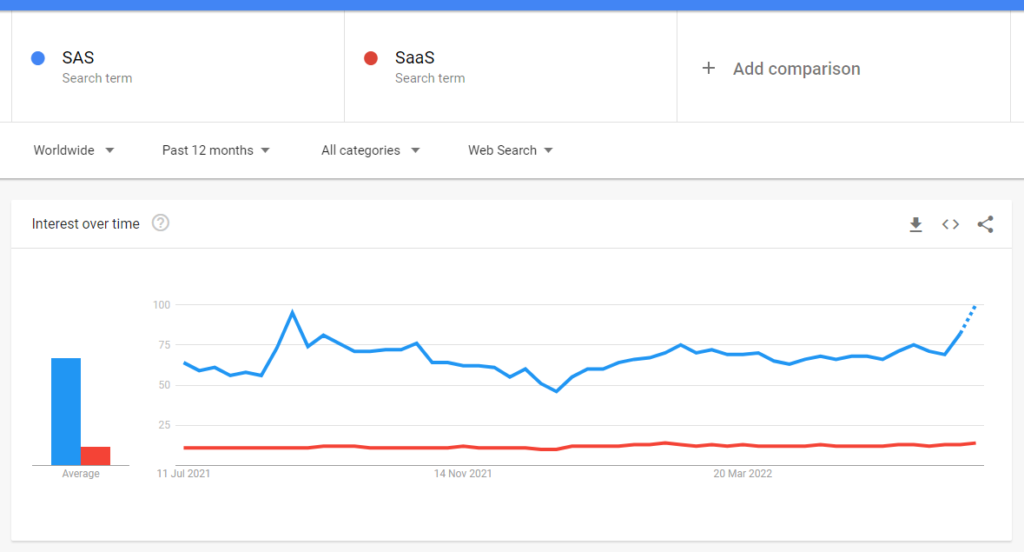SAS or SaaS, usually people pronounce it as “SAAS” but these are extremely two different things.Abbreviations are a common thing in the IT industry or in general in the tech world hence the confusion especially when you’re new to the IT industry.
SAS is a Statistical Analysis System whereas SaaS means Software As A Service. When you look at the popularity considering google search, Google Trends clearly shows SAS is the winner.

What is SAS?
SAS stands for the “Statistical Analysis Software“, a statistical software suite used for data management, advanced analytics, multivariate analysis, business intelligence, and predictive analytics.
In SAS you can literally play with a huge amount of data and find meaningful insights by writing a few lines of code. It’s a premium, widely used software suite by many big companies where they prefer to make data driven decisions.
There are tons of tutorials with real life examples available here to learn and kick start your career in the analytics field.
What are SAS Modules:
Here are some commonly used SAS modules or components:
BASE SAS :
It is a core component which contains a data management facility and a programming language for data analysis. Base SAS is supported and accessed through many SAS applications, including SAS display manager, Enterprise Guide, and SAS Studio
SAS/STAT® :
Take advantage of extensive statistical capabilities to meet the data analysis needs of your entire organization.
SAS/ACCESS® Software:
Read, write and update data regardless of its native database or platform. You can easily connect to databases such as Teradata, SQL Server, Oracle DB2 etc.
SAS/GRAPH:
You can create simple and complex graphs using this component.
SAS® Viya® :
Conquer your analytics challenges, from experimental to mission critical, with faster decisions in the cloud. SAS Viya enables everyone – data scientists, business analysts, developers and executives alike – to collaborate, scale and operationalize insights, everywhere.
SAS® Data Management:
Ensure better, more reliable data integrated from any source.
SAS® Enterprise Miner™ :
Streamline the data mining process to create highly accurate predictive and descriptive models based on large volumes of data.
SAS® Visual Data Mining and Machine Learning :
Solve your most complex problems faster with a single, integrated in-memory environment.
What is SaaS?
Software as a service (SaaS) is a software licensing and delivery model in which software is licensed on a subscription basis and is centrally hosted. SaaS is also known as “on-demand software” and Web-based/Web-hosted software. Whenever you want you can start using their services and stop services when you don’t need it.
It is a way of delivering applications over the Internet—as a service. Instead of installing and maintaining software, you simply access it via the Internet, freeing yourself from complex software and hardware management.
SaaS customers have no hardware to buy, install, maintain, or update software. Access to applications is easy: You just need an Internet connection. That’s it.
There are a lot of startups or big companies that use the SaaS model to offer various solutions. Few of them are listed here:
Top SaaS companies:
- Salesforce
- Microsoft
- Google workspace
- Cisco
- ServiceNow
- Workday
- HubSpot
- Slack
- Shopify
- Amazon Web Services (AWS) SaaS
- Tableau
- Github
- Zoom
- MailChimp
- Notion
- Zapier
- Typeform
- Figma
- Atlassian
- Webflow
FAQ
SAS stands for the “Statistical Analysis Software“, a statistical software suite used for data management, advanced analytics, multivariate analysis, business intelligence, and predictive analytics.
SAS or SaaS, usually people pronounce it as the same “SAAS” but these are extremely two different things. SAS is a Statistical Analysis System whereas SaaS means Software As A Service.